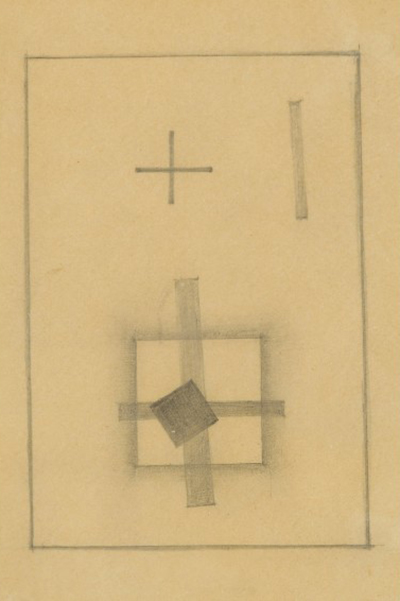Artist Malevich is most famous for his contributions to the Suprematist movement. Despite the simplicity of some of the compositions, he would still require good levels of study in preparation for the final paintings, one of which is displayed here.
The image in front of us here is entirely simple, and typical of the Suprematist movement. There is a small border which encapsulates the composition within the larger piece of paper, and then inside we find a whole series of squares, lines and crosses. The crosses would suit Malevich's abstract style perfectly, but they also delivered a religious tone to his paintings which was entirely appropriate considering its role within Russian life at the time. Indeed, the impact of Christianity is still particularly strong within parts of Eastern Europe. Malevich would continue to experiment with crosses in various arrangements throughout his use of Suprematism, but less so later on when he re-imagined this approach in the form of Neo-Suprematism. With regards this study, there is a single cross at the top, with a narrow rectangle close by. Below is a more complex arrangement with cross, square and also a bezelled border which suggests depth to an otherwise flat artwork.
The artist would have to be careful in later life as the ruling authorities in his native country became concerned about the modern style of his work. Some would be left in Germany in order to protect, whilst some of his other paintings would be seized and destroyed. Despite falling into controversy during that period, Malevich is today highly celebrated around the country and is seen as someone that Russians should be proud of and who has left an artistic legacy which is still felt today all around the world. This legacy is underlined by the number of exhibitions of his work that continue to pop up all across the continent, as well as further afield such as in the US too.
Malevich would spend time in the company of a number of other highly significant artists during his career, most notably Marc Chagall. This Belarus-born painter would later relocate to France but came from a fairly similar background to Malevich and is another example of this impressive culture found within this part of Europe. Some of Chagall's most famous paintings included the likes of Blue Violinist, La Mariee and I and the Village. His work differed considerably from that of Malevich, but they shared similar views with regards the importance of modern art and how it should be allowed to flourish alongside more traditional methods. The term Russan Avant-Garde refers to a wider group who shared these views and worked together in order to build support for some of these modern art styles within a relatively traditionally-minded nation. Ultimately, some would eventually feel it necessary to permanently move abroad, whilst others stubbornly remained, hoping to force change from within.




